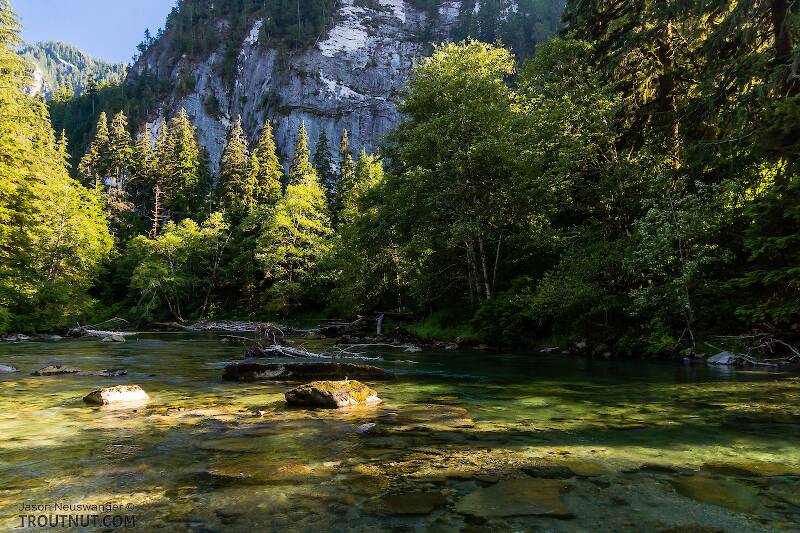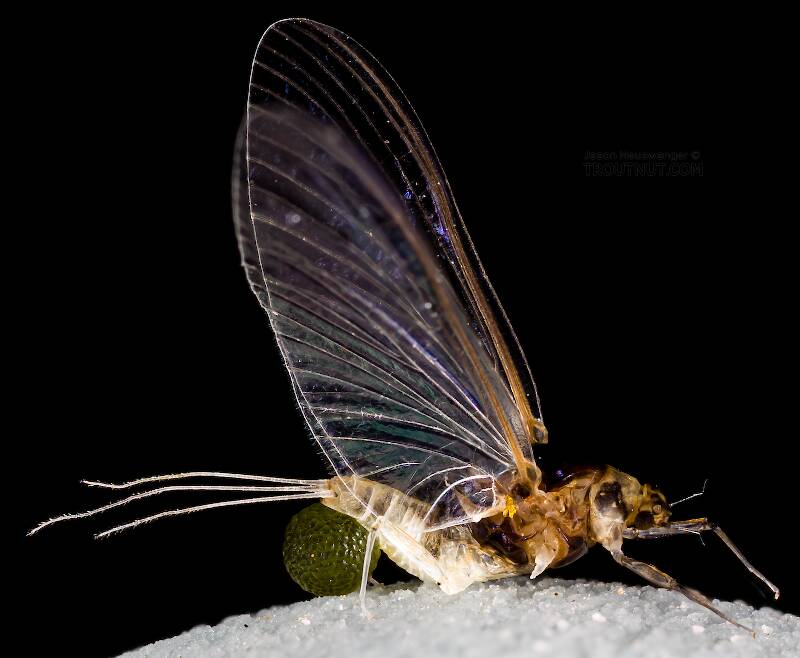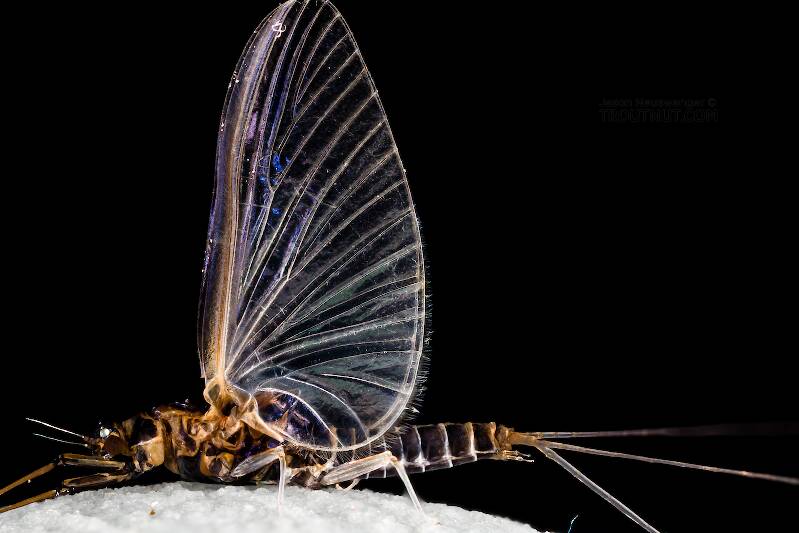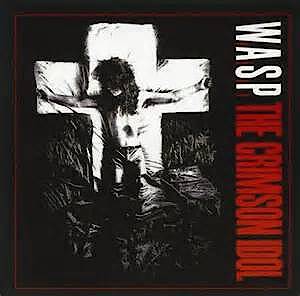
Salmonflies
Pteronarcys californica
The giant Salmonflies of the Western mountains are legendary for their proclivity to elicit consistent dry-fly action and ferocious strikes.
Featured on the forum

Nymphs of this species were fairly common in late-winter kick net samples from the upper Yakima River. Although I could not find a key to species of Zapada nymphs, a revision of the Nemouridae family by Baumann (1975) includes the following helpful sentence: "2 cervical gills on each side of midline, 1 arising inside and 1 outside of lateral cervical sclerites, usually single and elongate, sometimes constricted but with 3 or 4 branches arising beyond gill base in Zapada cinctipes." This specimen clearly has the branches and is within the range of that species.

Troutnut is a project started in 2003 by salmonid ecologist Jason "Troutnut" Neuswanger to help anglers and
fly tyers unabashedly embrace the entomological side of the sport. Learn more about Troutnut or
support the project for an enhanced experience here.
This topic is about the Mayfly Family Leptohyphidae
Read about the Tricorythodes genus for details. It is very important to trout anglers and it's the only significant trout stream genus in this family.Most of the other genera are found only in warm waters in Mexico and the Southwest.
Example specimens
Adirman on Sep 4, 2010September 4th, 2010, 12:22 am EDT
I've never fished a trico hatch before, but I've heard that those bugs are pretty tough to fish. Many guys don't even bother w/ em cause of the size of the flies(20-26). Although I have a few patterns in my box, I've never used them. Is it worth it to fish the tricos?
Lastchance on Sep 4, 2010September 4th, 2010, 3:58 am EDT
It just depends on how you look at the idea. I love 'em because they challenge me and I get to test my skills. Plus, I can fish them in the daylight and the hatch can last for months with the right weather. I like competing against them, if one can look at it that way. It's not easy, but I think it's great fun. The small tippet, small flies, the casting that needs to be pretty good, and the absence of micro drag, makes it challenging.
Oldredbarn on Sep 4, 2010September 4th, 2010, 5:33 am EDT
Bruce,
Well put mister! Many of your points would fairly well discribe why we fly fish in the first place. If someone read your short discription they would have a good view of what it's all about.
Spence
Well put mister! Many of your points would fairly well discribe why we fly fish in the first place. If someone read your short discription they would have a good view of what it's all about.
Spence
"Even when my best efforts fail it's a satisfying challenge, and that, after all, is the essence of fly fishing." -Chauncy Lively
"Envy not the man who lives beside the river, but the man the river flows through." Joseph T Heywood
"Envy not the man who lives beside the river, but the man the river flows through." Joseph T Heywood
Martinlf on Sep 4, 2010September 4th, 2010, 9:30 am EDT
What Bruce said.
"He spread them a yard and a half. 'And every one that got away is this big.'"
--Fred Chappell
--Fred Chappell
Adirman on Sep 4, 2010September 4th, 2010, 12:04 pm EDT
I understand and agree w/ you. Someday, hopefully, oppurtunity will present itself for me to fish them! In the meantime, I have another question: is it the size of the fly that makes it harder to prevent what you guys call "microdrag" as compared to say, fishing a Iso hatch with a 12-16 or so on? Also, why do they say the casting must be more precise than other hatches like Iso?
Thanks,
Adirman
Thanks,
Adirman
GONZO on Sep 4, 2010September 4th, 2010, 4:49 pm EDT
A-man,
A 7X tippet on a #24 fly is proportionally thicker/stiffer than, say, a 5X tippet on a #14. (The #24 is less than half the size of the #14, but the 7X tippet diameter is reduced by only about one third over 5X.) This often causes the tippet to negatively influence the drift: it is harder to create appropriate slack in the tippet, and it behaves more like a rope as it interacts with minute current variations, dragging the little fly. As a consequence, some trico anglers use even finer tippets (8X-10X), but tactics of casting position, placement, and angle are also very important for getting a good drift, and these can sometimes be used to compensate for the effects of a thicker tippet.
Casting accuracy is at a premium because the "attraction distance" (the distance a fish will move to the fly) is often significantly reduced with small flies. The timing of casts can also be critical because many fish will develop a feeding rhythm when lots of flies are on the water. Casts that present the fly (accurately) in sync with that rhythm are more likely to succeed than casts that are out of sync. Accuracy and timing can be especially important with the larger fish.
A 7X tippet on a #24 fly is proportionally thicker/stiffer than, say, a 5X tippet on a #14. (The #24 is less than half the size of the #14, but the 7X tippet diameter is reduced by only about one third over 5X.) This often causes the tippet to negatively influence the drift: it is harder to create appropriate slack in the tippet, and it behaves more like a rope as it interacts with minute current variations, dragging the little fly. As a consequence, some trico anglers use even finer tippets (8X-10X), but tactics of casting position, placement, and angle are also very important for getting a good drift, and these can sometimes be used to compensate for the effects of a thicker tippet.
Casting accuracy is at a premium because the "attraction distance" (the distance a fish will move to the fly) is often significantly reduced with small flies. The timing of casts can also be critical because many fish will develop a feeding rhythm when lots of flies are on the water. Casts that present the fly (accurately) in sync with that rhythm are more likely to succeed than casts that are out of sync. Accuracy and timing can be especially important with the larger fish.
Adirman on Sep 6, 2010September 6th, 2010, 12:27 am EDT
I understand and than you. So, I imagine that long distance casts are pretty much out of the question when fishing small flies due to these micro-currents as well?
Quick Reply
Related Discussions
Topic
Replies
Last Reply
2
Jul 9, 2018
by Martinlf
by Martinlf
I agree with the nymph and emergence coments above
In the Mayfly Species Litobrancha recurvata by Beardius
In the Mayfly Species Litobrancha recurvata by Beardius
0
Aug 1, 2008
by Beardius
by Beardius
6
Oct 25, 2008
by Taxon
by Taxon







